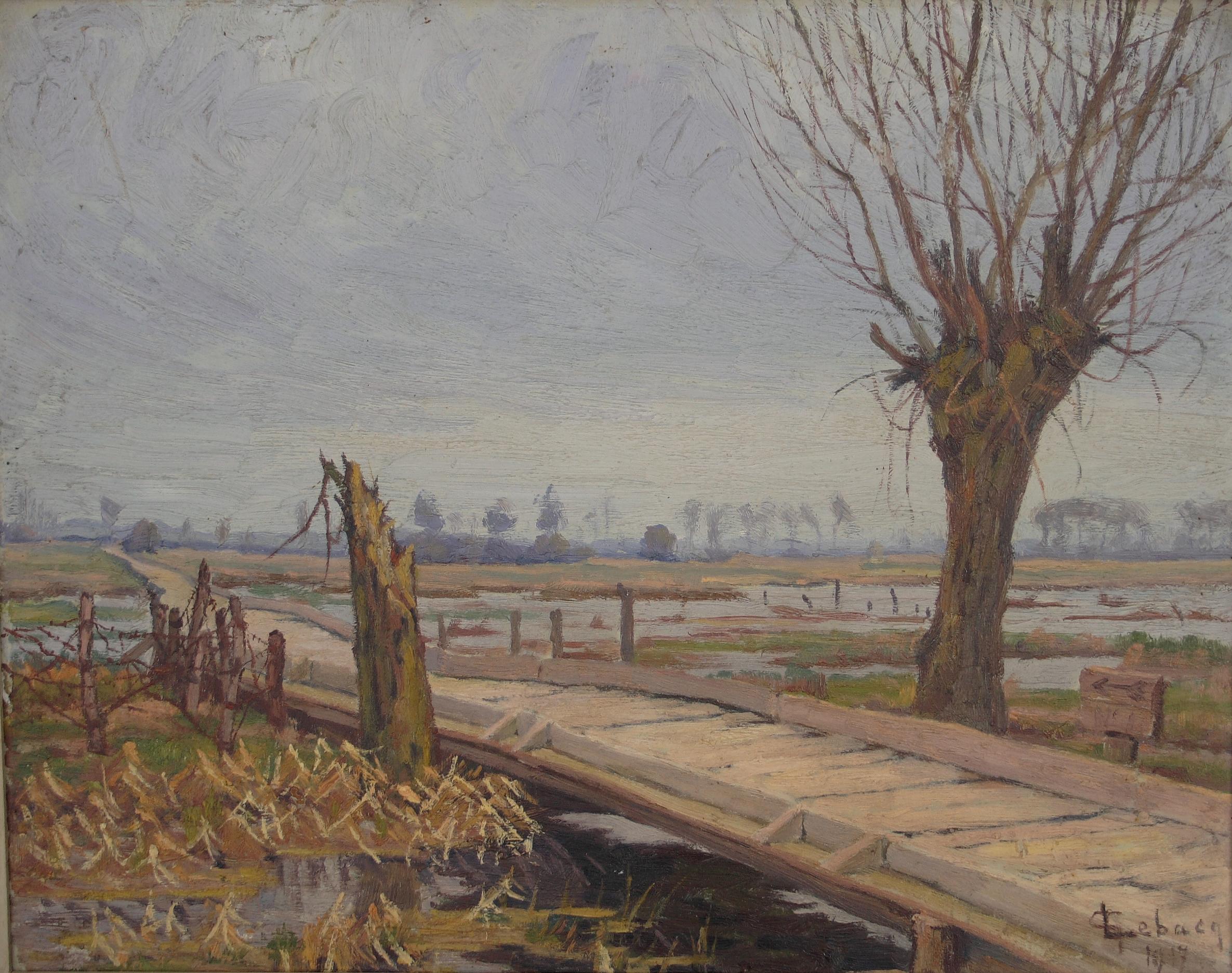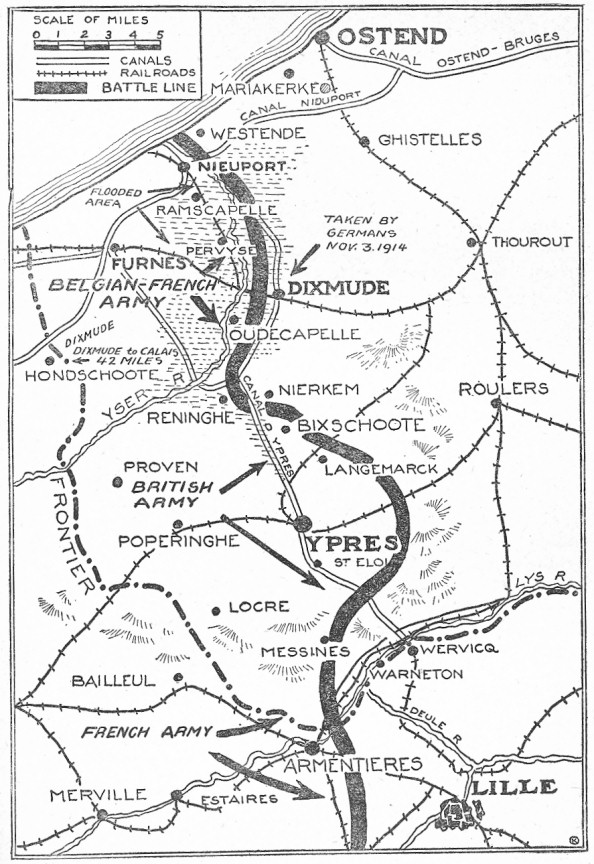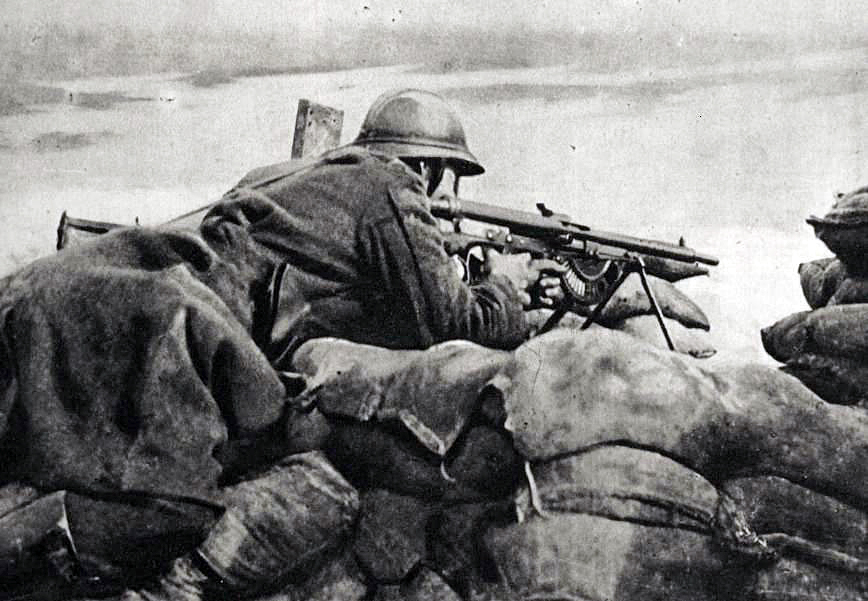Yser Front on:
[Wikipedia]
[Google]
[Amazon]
 The Yser Front (french: Front de l'Yser, nl, Front aan de IJzer or ), sometimes termed the West Flemish Front in British writing, was a section of the
The Yser Front (french: Front de l'Yser, nl, Front aan de IJzer or ), sometimes termed the West Flemish Front in British writing, was a section of the
 The Yser Front stretched along a distance of around from the Belgian
The Yser Front stretched along a distance of around from the Belgian
 The front was held uniquely by Belgian forces, which numbered around 221,000 men by September 1918. Throughout the war, the
The front was held uniquely by Belgian forces, which numbered around 221,000 men by September 1918. Throughout the war, the
La vie sur le front de l'Yser
at the ''
Stabilisation du front sur l'Yser
at ''Commemorer 14-18''
On the Yser Front, 1914
at
IJzerfront 14-18
Western Front (World War I) Military history of Belgium during World War I History of Flanders History of West Flanders
 The Yser Front (french: Front de l'Yser, nl, Front aan de IJzer or ), sometimes termed the West Flemish Front in British writing, was a section of the
The Yser Front (french: Front de l'Yser, nl, Front aan de IJzer or ), sometimes termed the West Flemish Front in British writing, was a section of the Western Front Western Front or West Front may refer to:
Military frontiers
* Western Front (World War I), a military frontier to the west of Germany
*Western Front (World War II), a military frontier to the west of Germany
*Western Front (Russian Empire), a maj ...
during World War I
World War I (28 July 1914 11 November 1918), often abbreviated as WWI, was List of wars and anthropogenic disasters by death toll, one of the deadliest global conflicts in history. Belligerents included much of Europe, the Russian Empire, ...
held by Belgian
Belgian may refer to:
* Something of, or related to, Belgium
* Belgians, people from Belgium or of Belgian descent
* Languages of Belgium, languages spoken in Belgium, such as Dutch, French, and German
*Ancient Belgian language, an extinct languag ...
troops from October 1914 until 1918. The front ran along the Yser river
The Yser ( , ; nl, IJzer ) is a river that rises in French Flanders (the north of France), enters the Belgian province of West Flanders and flows through the ''Ganzepoot'' and into the North Sea at the town of Nieuwpoort.
The source of the Yse ...
(IJzer) and Yser Canal
The Ieperlee (or ''Ypres-Ijzer Canal'') is a canalized river that rises in Heuvelland in the Belgian province of West Flanders and flows via the city of Ypres (Ieper) into the Yser at Fort Knokke.
The river is long. Its name is derived from ''i ...
(Ieperlee) in the far north-west of Belgium and defended a small strip of the country which remained unoccupied. The front was established following the Battle of the Yser
The Battle of the Yser (french: Bataille de l'Yser, nl, Slag om de IJzer) was a battle of the First World War that took place in October 1914 between the towns of Nieuwpoort and Diksmuide, along a stretch of the Yser River and the Yperlee ...
in October 1914, when the Belgian army succeeded in stopping the German advance after months of retreat and remained largely static for the duration of the war.
Background
During the early campaigns of 1914, the Belgian army had been pushed out of the fortified cities ofLiège
Liège ( , , ; wa, Lîdje ; nl, Luik ; german: Lüttich ) is a major city and municipality of Wallonia and the capital of the Belgian province of Liège.
The city is situated in the valley of the Meuse, in the east of Belgium, not far fro ...
, Namur
Namur (; ; nl, Namen ; wa, Nameur) is a city and municipality in Wallonia, Belgium. It is both the capital of the province of Namur and of Wallonia, hosting the Parliament of Wallonia, the Government of Wallonia and its administration.
Na ...
and Antwerp
Antwerp (; nl, Antwerpen ; french: Anvers ; es, Amberes) is the largest city in Belgium by area at and the capital of Antwerp Province in the Flemish Region. With a population of 520,504,
by the German advance. Although they succeeded in delaying the Germans at some actions, they were forced to withdraw, first to Antwerp, and into the far north-west of Belgium. By October 1914, the Belgian forces were holding a position along the Yser
The Yser ( , ; nl, IJzer ) is a river that rises in French Flanders (the north of France), enters the Belgian province of West Flanders and flows through the '' Ganzepoot'' and into the North Sea at the town of Nieuwpoort.
The source of the ...
and Ieperlee
The Ieperlee (or ''Ypres-Ijzer Canal'') is a canalized river that rises in Heuvelland in the Belgian province of West Flanders and flows via the city of Ypres (Ieper) into the Yser at Fort Knokke.
The river is long. Its name is derived fr ...
canal. After months of retreat, the Belgian forces were considerably reduced and were exhausted. They flooded a large expanse of territory in front of their lines, stretching as far south as Diksmuide
(; french: Dixmude, ; vls, Diksmude) is a Belgian city and municipality in the Flemish province of West Flanders. The municipality comprises the city of proper and the former communes of Beerst, Esen, Kaaskerke, Keiem, Lampernisse, Leke ...
. Between 16 and 31 October 1914, the Belgians held off the German army at the Battle of the Yser
The Battle of the Yser (french: Bataille de l'Yser, nl, Slag om de IJzer) was a battle of the First World War that took place in October 1914 between the towns of Nieuwpoort and Diksmuide, along a stretch of the Yser River and the Yperlee ...
, suffering 3,500 killed and 15,000 wounded. The Battle of the Yser established a front line which would endure until 1918.
Geography
 The Yser Front stretched along a distance of around from the Belgian
The Yser Front stretched along a distance of around from the Belgian North Sea
The North Sea lies between Great Britain, Norway, Denmark, Germany, the Netherlands and Belgium. An epeiric sea on the European continental shelf, it connects to the Atlantic Ocean through the English Channel in the south and the Norwegian ...
coast between Nieuwpoort and Westende
Westende is a town in Flanders, one of the three regions of Belgium, and in the Flemish province of West Flanders. It lies on the Belgian coast, also called the Flemish coast. It used to be the far west (West-ende: Dutch for west-end) of the i ...
, stretching south-east along the Ieperlee, encompassing both Ramskapelle and Pervijze
Pervijze (french: Pervyse, English ''Pervyse'') is a small rural village in the Belgian province of West Flanders, and a part ("Deelgemeente") of the municipality of Diksmuide. Pervijze has an area of 12.23 km² and almost 900 inhabitants.
Be ...
. From Pervijze, the line then arched south-east between the Yser and Ieperlee, down to Oudekapelle
Oudekapelle is a small village in the Belgian province of West Flanders and a part ("deelgemeente") of the municipality of Diksmuide. Oudekapelle is a small village with only about ten houses around the church and farms on its territory. It has ab ...
and Reninge. Diksmuide had fallen to German forces shortly before the Battle of the Yser.
The front protected a small region of north-west Belgium which remained unoccupied. King Albert I, commander-in-chief of the Belgian Army, established his headquarters in Veurne
Veurne (; french: Furnes, italic=no, ) is a City status in Belgium, city and Municipalities in Belgium, municipality in the Belgium, Belgian Provinces of Belgium, province of West Flanders. The municipality comprises the town of Veurne proper an ...
, one of the salient's only towns. The Belgian government, under Charles de Broqueville
Charles Marie Pierre Albert, 1st Count de Broqueville (4 December 1860 – 5 September 1940) was the prime minister of Belgium, serving during World War I.
Before 1914
Charles de Broqueville was born into an old noble family with its roots in ...
, established itself in exile in Sainte-Adresse, a suburb of the nearby French city of Le Havre
Le Havre (, ; nrf, Lé Hâvre ) is a port city in the Seine-Maritime department in the Normandy region of northern France. It is situated on the right bank of the estuary of the river Seine on the Channel southwest of the Pays de Caux, very ...
.
Aspects
Belgian policy and diplomacy
Despite protecting the northern sector of the Western Front, the Belgian army at the Yser refused to participate in Allied offensives for most of the war. King Albert I, in command of the Belgian armed forces, believed that Belgium's neutrality meant that its army should only be used to further Belgium's national interests. Albert was sceptical of the value of offensive warfare, advocated by the British and French, which he believed to be costly and unable to achieve decisive victory. Albert believed that a mediated peace was inevitable and that it served Belgium's national interest to continue to protect the territory it already held until the Germans could be forced to open negotiations. Consequently, the Yser Front remained generally static for much of the war. Only after the failure of the Ludendorff Offensive in 1918 did the Belgian Army participate in an Allied offensive, theHundred Days Offensive
The Hundred Days Offensive (8 August to 11 November 1918) was a series of massive Allies of World War I, Allied offensives that ended the First World War. Beginning with the Battle of Amiens (1918), Battle of Amiens (8–12 August) on the Wester ...
, making successful advances into German-occupied Belgium.
On 28 September 1918, in the Fifth Battle of Ypres
The Fifth Battle of Ypres, also called the Advance in Flanders and the Battle of the Peaks of Flanders (french: Bataille des Crêtes de Flandres) is an informal name used to identify a series of World War I battles in northern France and sout ...
, the ''Groupe d'Armées des Flandres'' ("Flanders Army Group" or GAF), under the command of Albert I with the French General Jean Degoutte
Jean Marie Joseph Degoutte (18 April 1866, Charnay, Rhône – 31 October 1938) was a French general active in the colonies and the First World War.
Colonial career
Degoutte joined the 31st Artillery Regiment on 7 March 1887 and then attended Sai ...
as Chief of Staff, composed of 12 Belgian divisions, 10 British divisions of the Second Army and 6 French divisions of the Sixth Army attacked the Germans and advanced up to . After the following Battle of Courtrai, the GAF advanced some more.
Daily life
 The front was held uniquely by Belgian forces, which numbered around 221,000 men by September 1918. Throughout the war, the
The front was held uniquely by Belgian forces, which numbered around 221,000 men by September 1918. Throughout the war, the Belgian Army
The Land Component ( nl, Landcomponent, french: Composante terre) is the land branch of the Belgian Armed Forces. The King of the Belgians is the commander in chief. The current chief of staff of the Land Component is Major-General Pierre Gérard. ...
was supplemented by escapees of military age (''évadés'') from German-occupied Belgium. Altogether, around 20,000 Belgian soldiers died on the Yser during the war. In 1914, the Christmas truce ckb: ئاگربەستی کریسماس
The Christmas truce (german: Weihnachtsfrieden; french: Trêve de Noël; nl, Kerstbestand) was a series of widespread unofficial ceasefires along the Western Front of the First World War around Christm ...
was observed in a number of parts of the line and a few Belgian and German troops met in no-man's land
No man's land is waste or unowned land or an uninhabited or desolate area that may be under dispute between parties who leave it unoccupied out of fear or uncertainty. The term was originally used to define a contested territory or a dump ...
between the trenches.
Life on the front line was poor, with soldiers forced to live and sleep in unsanitary trenches, in mud ploughed up by artillery fire. Typhus
Typhus, also known as typhus fever, is a group of infectious diseases that include epidemic typhus, scrub typhus, and murine typhus. Common symptoms include fever, headache, and a rash. Typically these begin one to two weeks after exposure. ...
was a major problem among Belgian troops on the Yser Front, where up to 7,000 soldiers died from diseases contracted there.
Politics and the Flemish Movement
Within the Belgian army, the experience of the Yser Front had led to political upheaval. Of the Belgian soldiers on the Yser, between 65 and 80 percent wereFlemish
Flemish (''Vlaams'') is a Low Franconian dialect cluster of the Dutch language. It is sometimes referred to as Flemish Dutch (), Belgian Dutch ( ), or Southern Dutch (). Flemish is native to Flanders, a historical region in northern Belgium; ...
, speaking Dutch, while many of the Walloons
Walloons (; french: Wallons ; wa, Walons) are a Gallo-Romance ethnic group living native to Wallonia and the immediate adjacent regions of France. Walloons primarily speak '' langues d'oïl'' such as Belgian French, Picard and Walloon. Wallo ...
spoke dialects such as Gaumais or Walloon. The language of command, however, was French and many Flemish soldiers felt resentful at their treatment by the French-speaking officer class. For the Flemish troops, the disquiet culminated in 1916 with the establishment of the '' Frontbeweging'' ("Front Movement") which gained a membership of 5,000 soldiers. Although part of the Flemish Movement
The Flemish Movement ( nl, Vlaamse Beweging) is an umbrella term which encompasses various political groups in the Belgium, Belgian region of Flanders and, less commonly, in French Flanders. Ideologically, it encompasses groups which have sought ...
, the ''Frontbeweging'' called for greater regional autonomy in Belgium, rather than Flemish independence, and the creation of Dutch-speaking regiments. Its most celebrated work was the '' Open Letter to the Belgian King Albert I'', drafted by Adiel Debeuckelaere, in 1917 which aired many of the movement's grievances.
Although the ''Frontbeweging'' was unsuccessful in the short term, it succeeded in creating a dedicated political party, the ''Frontpartij
The ''Frontpartij'' (Dutch; "Front Party") was a Belgian political party that campaigned for increasing recognition for the Flemish people and their language. Originating from the earlier ''Frontbeweging'' ("Front Movement"), the ''Frontpartij'' ...
'', in post-war Belgium after the German defeat delegitimized many other parts of the Flemish Movement implicated in collaboration with the occupation authorities.
See also
* Dodengang - section of preserved Belgian trenches near Diksmuide *IJzertoren
The Yser Towers ( nl, IJzertoren) are a monument complex near the Yser river at Diksmuide, West Flanders in Belgium. The first tower was built in 1928–30 to commemorate the Belgian soldiers killed on the surrounding Yser Front during World W ...
- a monument to the soldiers killed on the Yser Front
* Brothers Van Raemdonck
References
Bibliography
* * *External links
{{commons category, Yser FrontLa vie sur le front de l'Yser
at the ''
Musée royal de Mariemont
The Royal Museum of Mariemont (french: Musée royal de Mariemont) is a museum situated in Mariemont, near Morlanwelz, in Belgium. It is constituted around the personal collection of art and antiquities owned by the industrialist Raoul Warocqué (1 ...
''Stabilisation du front sur l'Yser
at ''Commemorer 14-18''
On the Yser Front, 1914
at
British Pathé
British may refer to:
Peoples, culture, and language
* British people, nationals or natives of the United Kingdom, British Overseas Territories, and Crown Dependencies.
** Britishness, the British identity and common culture
* British English, ...
.
IJzerfront 14-18
Western Front (World War I) Military history of Belgium during World War I History of Flanders History of West Flanders